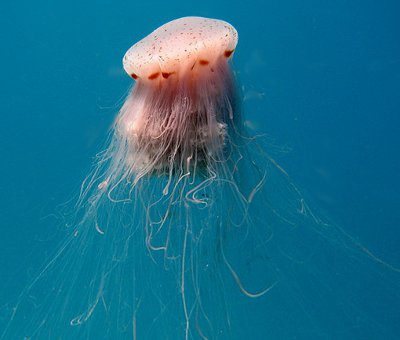Lion's Mane Jellyfish
Category: Jellyfish

Facts about Lion's Mane Jellyfish, "Scientific name for Lion's Mane Jellyfish is Cyanea capillata". The Lion’s mane Jellyfish is known to be one of the world’s longest animal. The species is known to have varying sizes ranging from diameters of 1/2 inch to 8 feet (1.27 cm to 2.43 meters). The Lion’s mane jellyfish has tentacles that are divided into eight groups of more than 100 tentacles each, reaching up to 108 feet (32.91 meters)tall. The largest ever recorded tentacles of this species were as long as 120 feet (36.57 meters).
The Lion's Mane Jellyfish also has a great range of color variation. Large Lion’s mane jelly have a color range from bright red to dark purple while their smaller counterparts can be any color from tan to orange. The Lion's Mane Jellyfish species gained its name from the color of its tentacles which are usually red or yellow in color.
The Lion’s mane jellyfish undergoes four stages of growth: the larval stage, the polyp stage, the ephyrae stage, and the medusa stage.
Early in life the Lion’s mane jellyfish reproduces asexually but after reaching full maturity they reproduce sexually. The female Lion's Mane Jellyfish carries the fertilized eggs in her tentacles till they become larvae. The female Lion's Mane Jellyfish then deposits them on hard surfaces to allow them to grow into polyps. These polyps reproduce asexually giving rise to little creatures known as ephyraes. These ephyraes are the ones that break off the stacks and become fully grown jellyfish in the medusa stage.
The Lion’s mane jelly feeds on small fish, small shrimp, rotifers, copepods and other jelly fish.
The Lion's Mane Jellyfish is also known as hair jelly. It is the largest species of jellyfish. The Lion's Mane Jellyfish is fond of cold conditions, and it is mostly found in the northern Atlantic and Pacific Oceans.
The Lion’s mane jelly utilize their tentacles to capture their prey. If you encounter this species you may get a sting that causes some pain and redness on the stung area.
The following are some of the predators of the Lion’s mane jelly:
· Seabirds
· Ocean sunfish
· Sea turtles and
· Other species of jellyfish.
Lion's Mane Jellyfish Expels Waste and Eats Through the Same Orifice. Jellyfish have a unique opening designed to perform dull functions as both a mouth and an anus.
The life span for a Lion's Mane Jellyfish is about one year.

 Back To Category Jellyfish
Back To Category Jellyfish